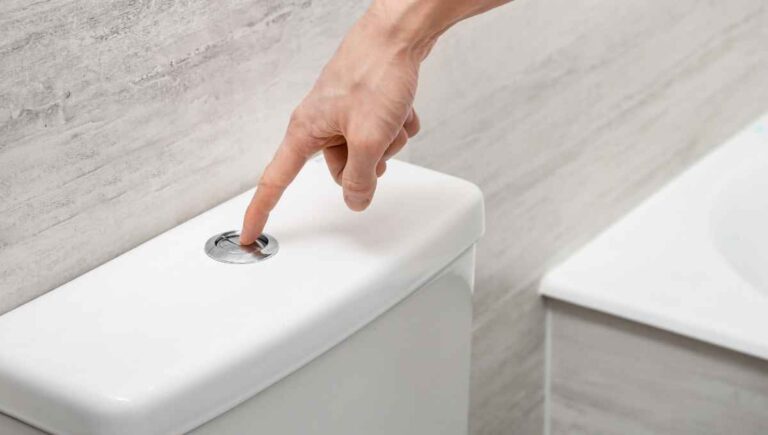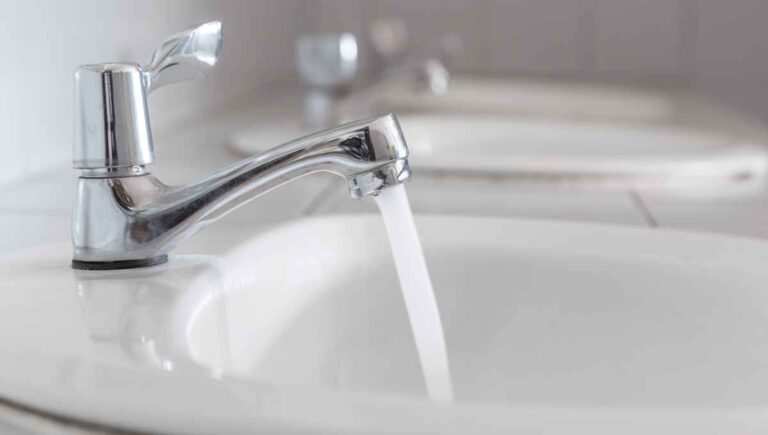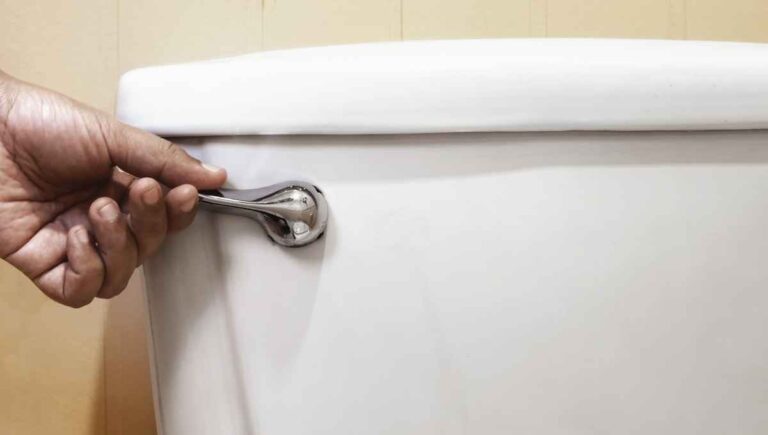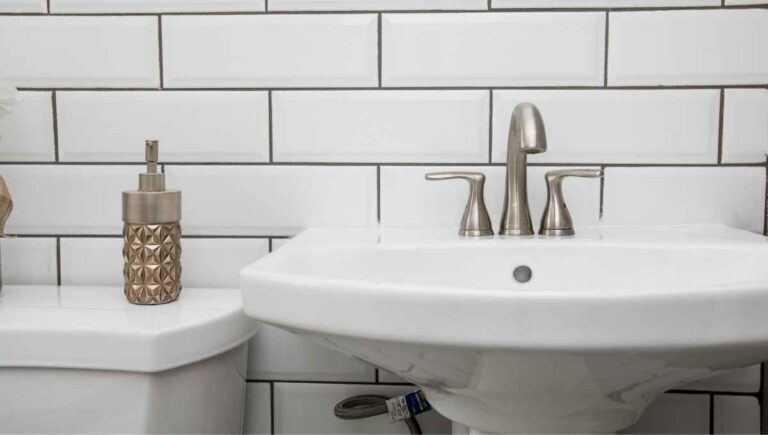Can You Move Bathroom Scales? (Scale Accuracy & Storage)

If you need to track your weight for medical reasons or if you’re trying to gain or lose weight, it’s important that your bathroom scale remains accurate. Many think moving a bathroom scale will make it lose accuracy. Is this true? Can you move bathroom scales?
You can move your digital or analog bathroom scale, but it should be calibrated afterward to maintain accuracy. Your scale should have come with instructions on how to calibrate it.
Of course, how it needs to be calibrated depends on if it’s digital or analog. We’ll discuss both and how to maintain your scales to keep them accurate, even if you move them. Let’s jump in!
This post contains affiliate links. This means Household Blogger may earn a commission should you make a purchase using any of our links. Please refer to our full affiliate disclosure policy for full details.
Here’s a Quick Pro Tip!
It’s important your bathroom scale remains accurate over time. Without accuracy, there’s not much point in using them. Luckily, even after you move a scale, it’s easy to ensure it remains accurate.
Here are three of our favorite scales. They are easy to calibrate, so you can move them around as much as you want!
1. Eufy Smart Scale – Comes with a free app that measures weight, heart rate, body fat, BMI, mustle and bone mass.
2. Kinlee Professional Grade Analog Scale – Low tech doesn’t have to mean inaccurate!
3. Health-O-Meter Mechanical Beam Scale – Use what the doctors use! Plus, it allows you to measure height!
Taking Care of Your Scales
First off, it’s important to make sure you are taking care of your scales properly. After a scale has been moved, it needs to be calibrated to ensure accuracy. This may look like recalibrating it digitally or, if it’s analog, turning the dial to ensure it hits zero when nothing is on it.
We’ll come back to that a bit later, don’t worry. First, let’s chat about what can happen to your scale to make it inaccurate in the first place. If you’re like me, your bathroom is pretty small, and keeping a scale out in the middle of everything means it’s just in the way.
But, if you store your scale somewhere out of the way, you need to make sure you’re putting it down in the same place every time you use it. Additionally, make sure you weigh yourself twice.
The first time calibrates it; the second gives you an accurate weight. You should be sure to distribute your weight carefully, as having more weight on one foot can also throw off accuracy.
Storage of Scales When Not In Use
But if you don’t keep your scale out all the time, how should you store it? If your scale is high-quality, you can store it on its side or flat, whichever is easier for your situation. On the other hand, if your scale is low-end, you may want to store it flat to ensure it doesn’t get too miscalibrated.
Either way you store it, it’s important to make sure it’s properly calibrated once laid back, flat, and ready to use. We recommend that you always place it in the same spot on your floor to eliminate variables from uneven flooring. Also, you should avoid placing it on the carpet, if at all possible, as the carpet can throw off calibration.
Keeping the Accuracy of Your Bathroom Scale
It’s vital that your bathroom scale maintains accuracy, and it makes sense to worry that you may have thrown off its calibration by moving it. Luckily, moving a scale doesn’t have to mean that it’s inaccurate forever.
However, if you don’t want to have to worry about inaccuracy, one step to take is to purchase a high-end scale. Unfortunately, lower-quality scales are more likely to lose accuracy over time and are less likely to recalibrate correctly.
If you are concerned about accuracy, we recommend purchasing a digital scale with an analyzer. These scales tend not to lose their accuracy over time, and they self-calibrate at each use.
When a unit self-calibrates, it takes the guesswork out of you having to calibrate your scale. This saves time, and it ensures that you’re getting accurate readings. Plus, this model tells you your body fat, water, muscle, and bone mass percentages!
Is Your Scale Accurate?
Your bathroom scale should, in general, be accurate if calibrated correctly. At most, it should be off by two-tenths of a pound (0.2lbs) for a digital scale and half a pound (0.5lbs) for an analog scale.
In most cases, you’ll find that digital scales are more accurate than their analog counterparts. While there are a few different reasons for this, the main one is that it’s easier to miscalibrate an analog or mechanical scale.
If you are concerned that your scale isn’t accurate, we can help! Here is an easy trick to test your scale for accuracy:
- Grab two unopen five (or ten, initial weight doesn’t matter too much here) pound bags of flour or sugar. You want your bags to be unopened to ensure they’re at the correct weight. Additionally, only use paper or other lightweight bags, as they shouldn’t affect the weighing process.
- Turn your scale on and ensure it’s at zero.
- Place only one bag on the scale. It should weigh five (or ten) pounds exactly.
- Remove the bag and allow the scale to hit zero once again.
- Reweigh the object at least five times, ensuring it hits zero each time you remove it, and check the weight each time to ensure it remains at exactly five pounds.
- Once you’ve established that it’s accurate at five pounds, add the second bag. It should weigh ten pounds. As long as the weight isn’t off at this point, you know your scale is accurate!
- If you aren’t getting exactly five pounds, but it is weighing the same amount each time, for example, six pounds, you can assume that your scale is off by one pound and adjust for this when you weigh yourself, or you can recalibrate your scale, so it’s no longer off by said pound.
If you aren’t comfortable using your baking products for this, you can use small hand weights, typically five pounds or less, instead!
Troubleshooting an Inaccurate Scale
If you’ve tested your scale and it’s giving you inaccurate weights, there are multiple reasons why this could happen. Most likely, it’s uncalibrated. However, there are other reasons.
One common mistake people make when weighing themselves is not making sure that the scale is placed on an even surface before standing on it. For example, if the ground is sloped, the scale can’t calibrate correctly.
Additionally, if the scale is placed on a carpet or another soft surface, it won’t read accurately. This is because the cushion provided by the carpet prevents the scale from balancing correctly, leading to inaccurate results.
Similarly, if you don’t distribute your weight evenly when you step on the scale, you may notice that your readings are off. For example, if you place most of your weight on one foot, the scale can’t balance properly, and your reading will be inaccurate.
You might also enjoy our post on How Long Do Bathroom Scales Last?
Making Your Scale Trustworthy
This is why you should always place your bathroom scale on a flat, hard surface in your bathroom and stand as evenly and still as possible while taking a reading to ensure accuracy.
Your scale will give you different readings if you constantly reposition it without calibrating it. Additionally, your scale may give you two different weights if you don’t distribute your weight correctly.
If your scale still seems incorrect, follow the steps listed above to check its reading capabilities, and if the scale is truly reading weights incorrectly, recalibrate it. Often, recalibrating is as easy as pressing a button, adjusting a dial, or simply turning it off and back on.
Calibration of a Bathroom Scale
While a scale can tell you the wrong weight if improperly calibrated, it’s easy to fix. The first step is knowing whether your scale is digital or analog (mechanical.) If it’s digital, it should have an LED display. If it’s analog, it will have a needle and a series of numbers always on display.
These scales can both be accurate, and it’s a personal preference as to which is better, digital or analog. However, they both can become off balance and show incorrect weights if they have been moved.
Can You Calibrate a Digital Bathroom Scale?
Yes! Digital scales may seem intimidating due to the LED display and lack of physical dials to adjust, but they’re really not difficult to adjust.
Follow these simple steps to ensure your bathroom scale is properly calibrated after moving it:
- Ensure the scales are on a smooth, hard, flat surface. Having your scale on an uneven or soft surface (such as a carpet) can interfere with the scale’s balance and will throw off your accuracy.
- Turn the scale on if necessary.
- Press one foot down on the scale, ensuring you’re hitting the sensor portion. Depending on the type of scale, you should see dashes or zeros come up on the LED screen.
- Immediately take your foot off the scale when you see these appear.
- Allow your scale to turn off; this typically takes around one minute.
- When you turn the scale back on, it should be calibrated.
This process may be different if your digital scale has a CAL, ON/OFF, FUNCTION, or MODE button. In cases of manual calibration buttons, press the button and follow the instructions on the screen or provided in the owner’s manual for best results.
Typically, you’ll just need to press the calibrate button, let the scale hit zero, then stand on the scale multiple times to ensure the readings are all the same, but it depends on the brand. Always follow the manufacturer’s directions to ensure proper calibration!
How to Calibrate an Analog Bathroom Scale
If you have a mechanical or analog bathroom scale, calibrating it is quite different from a digital model. The good news is, even though it’s different, it doesn’t mean it’s more difficult! In fact, calibrating a mechanical scale might be even easier than a digital one!
Here’s how to calibrate an analog scale:
- Start by placing your scale on a hard, flat surface.
- Locate the calibration knob; it’s typically on the base and is about the size of a dime.
- Make sure there is no weight on the scale and that it’s settled, then turn the calibration knob until it’s resting on zero.
- Press down on the scale with your hand. It doesn’t matter how firmly you press or that it reads exactly the same each time; you just want to ensure that the scale needle goes back to zero once you remove your hand.
- Once you’re confident the needle will go back to zero, stand on the scale to verify your weight, then step off and check that the needle has gone back to zero. If it does, your scale is calibrated!
Other Things That Throw Off Your Scale
Before we wrap up this article, we’d be remiss not to discuss other common mistakes people make when they weigh themselves that can throw off the scale’s results. Did you know that not every mistake a scale makes is caused by miscalibration?
Here are a handful of other things to consider before attempting to recalibrate your scale:
- Time of Day – If you’re noticing that your weight is fluctuating, consider when you’re weighing yourself. If you don’t check your weight at the same time every day (Tip: always check first thing in the morning!), the results may vary due to factors like what you’ve eaten or drank throughout the day.
- Weight Distribution – If you tend to favor one leg, your weight might be off due to more pressure being placed on one spot on the scale.
- Surface Placement – Always keep your scale on a hard, flat, even surface. Placing your scale somewhere sloped or on a carpet can throw off the balance and affect your readings.
- Battery Life – If your scale seems off, it might just be time to change the batteries! Likewise, if your scale is dying quickly or not showing the proper weight, it might just be a battery issue.
- Cleanliness of the Scale – A dirty or grimy digital scale can interfere with your scale’s ability to take proper metrics. Not only can this throw off weight, but if your scale measures mass, bone density, etc., it may also throw off these measurements!
Some Final Thoughts
Moving your scale doesn’t have to be a death sentence for accurate measurements. As long as you are confident in your ability to calibrate your scale, you can move it as often as you want!
Luckily, for most scales, calibrating it is as easy as pressing a button or turning a knob. Remember, however, if you doubt the proper way to calibrate your scale, refer to the manufacturer’s instructions.
Plus, if you’ve calibrated your scale but you still think it’s off, make sure you check your environment. For example, a carpet, low batteries, or dirt are all enough to make your scale unbalanced and give incorrect measurements.












